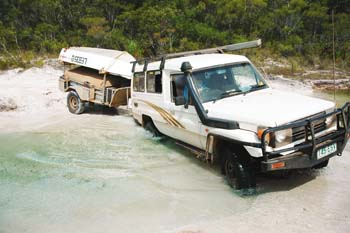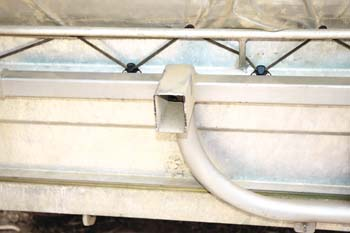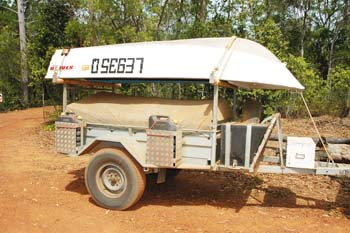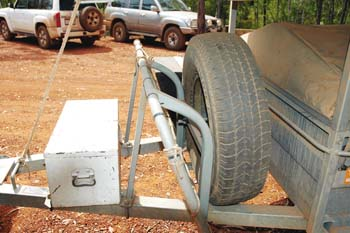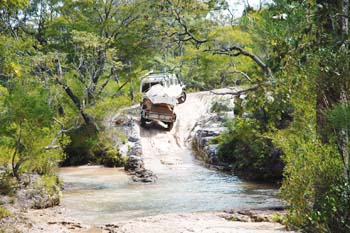Have Boat - Will Bush Bash
- NAFA
- Jul 1, 2007
- 9 min read
Ken Stien passes on a few tips for getting off the beaten track, and taking your boat with you.
The demographics of the Australian population have changed greatly over the past 20 years. People seem to be more affluent, have more leisure time and are prepared to travel. If you doubt this, take a trip up Cape York during the peak season and check out the traffic situation. You’ll be lucky to find a place to put up a tent in some popular spots.
The explosion in ownership of 4x4 vehicles is one factor. When you visit one of those ‘out-of-the-way’ places, you can bet you won’t be alone. It will be very interesting to see whether the sharp increases in fuel prices will have a moderating effect!
Some people are just cruising for a look, while others just want to get there and get home to say they’ve done it. I guess most are like myself. They want to take it slowly, have a good look and enjoy the place. Essential to this enjoyment is the necessity of taking some type of fishing craft along for the ride — and using it!
I say Cape York, but it could be anywhere from there to the Kimberley. I’ll use the Cape as my yardstick because, as a north Queenslander, I know the area well. Roads on the Cape are very tough on vehicles, and representative of the offroad conditions found off the beaten track.
The History My first foray north of Cooktown was in the summer of 1968. We ventured up in my Dad’s old Landrover, but didn’t take a boat. We caught barra on foot though, and had a ball doing it. On that trip I came down with a bad case of Cape fever — and I’m still suffering.
It wasn’t until the early 1980’s that we got fair dinkum and planned a traditional fishing safari, complete with boats. The next question was how to go about it. We briefly considered conventional boat trailers, but the corrugations and frequent wash-outs convinced us to car-top the boats.
My father and his mate carried a 3.7 m tinny on top of a trayback Landcruiser. This left me with a 4 m tinny to be carried on my son’s 4x4 Hilux ute. Luckily, my son was a fitter & turner/welder at a good friend’s engineering works, so we had the best of advice on tap. A bullet-proof boat rack was built for the old Hilux, and we headed off into the sunset.
Now nothing broke and we had a great couple of weeks, but getting that 4 metre tinny on and off the tall-standing Hilux was no picnic. My son had one of those fancy sunroofs fitted to the old Hilux, and driving along watching that boat move over our heads was enlightening, to say the least.
When the time came the following year for the annual Cape York sojourn, we sat down and had a good think. I was not keen on wrestling that heavy tinny back up on top, so we elected to use a conventional boat trailer. Did I mention my son worked in an engineering shop? We went through the trailer, analysed its weaknesses, then strengthened it considerably in the key areas. Standard Toyota split rims were added with a new axle and suspension, until we considered it would handle the rigours of the Cape York track.
My last trip with this rig was about three years ago when we went right to the tip and bashed our way into the Escape River system. That makes it about 15 years of Cape ramblings for this rig before I handed it over to my daughter and her partner, where it’s still going strong.
But everything is a compromise, and fitting in all the camping and fishing gear for a trip was always an effort. Light and bulky items went in the boat, but dust was always a hassle, Heavy items, or anything not completely dustproof, had to go inside my 4Runner, or, in later years, the Landcruiser Troopcarrier.
When I retired a few years ago, we had another rethink, especially as some places were very difficult to access with a conventional boat trailer, and the larger 4 metre tinny was getting to be a handful for this old bloke. Carrying a boat on top of the troopy did not appear to be an option because of the height, so the decision was made to purchase a purpose-built offroad box trailer with boat racks. This would give good cargo carrying ability, with the boat much easier to load and unload than off a vehicle, due to the reduction in height.
An experiment with a light 3.4 metre tinny was a disaster as it was far too unstable for me — especially in crocodile water. It was replaced with a much more stable 3.7 metre Stacer tinny. And that’s the present state of affairs. It lives on its conventional boat trailer with a 20 hp Yamaha outboard, most of the year, then goes atop the box trailer when the serious stuff is in the offing! A light-weight 15 hp Mariner outboard is carried in the trailer for the portable work, and Bob’s your Aunty.
The Choices The three options I’ve experienced are the choices to consider at the moment, if you want to overland a small boat on rugged tracks. Another alternative is to fly in and hire guides to squire you around. This concept has plenty of positives for a strictly fishing crew, but is less attractive for families.
So let’s now examine the three options in more detail. Before we do, lets take a moment to consider the parameters within which we operate. The corrugations will be horrendous — that’s a given. Washouts, bulldust, deepwater crossings and bush-bashing your own tracks — you’ll experience them all, sooner or later, if you plan to explore Cape York or any similar place. Any planning must allow for these conditions.
Option 1: Car-topping This is the simplest, but as with all systems, there are factors to consider- ARGUMENTS FOR You are not dragging anything behind your vehicle which is the biggest plus – especially in sandy terrain, severe grades or steep gullies.
ARGUMENTS AGAINST The main disadvantages as I see them are;
[a] Loading and unloading your boat. The average 3.7 metre tinny will weigh in the vicinity of 80 – 85 kg, which is a fair weight to handle on and off a high clearance 4x4 vehicle. You need to be young, fit and strong, and none of those words describe me!
[b] A car-topper raises your vehicle’s centre of gravity and in rugged country you need to keep this in mind.
[c] Be very careful of passing under low trees. You tend to forget the extra height of your rig, until you hear the scraping sounds from overhead.
[d] You need to ensure your vehicle can handle the extra load. You may need to upgrade springs, shocks and tyres. At least 10 ply rating tyres are recommended.
[e] The extra wind resistance will result in increased fuel consumption. It may be equal to or even greater than towing a trailer behind.
Car-topping is by far the most popular way for a bunch of blokes doing the traditional Cape York fishing trip into tiger country to carry their tinnies. Trayback Toyotas, Nissans and their ilk will often carry heavy canopies or strong frames to support the tinny. As long as these are strong, and the boat is not supported on bars attached to the vehicle’s roof gutters, there should be few problems. This system does not lend itself to daily launching and retrieving boats. It is best for extended stays of at least a week’s duration when you unload when you arrive and load prior to departure. At centres like Weipa, you will probably be able to hire trailers for daily use.
Option 2: Conventional boat trailers These must be designed for offroad conditions, or strengthened to handle the eternal corrugations. Axles, springs, shocks, wheels and tyres need to be top notch with the trailer chassis strengthened in vulnerable areas. Then the boat must be strapped down so it cannot move at all. The first thing that usually happens over the first few kilometers of corrugations is that the boat rollers will drop. Once my boat is set up properly, I tack-weld all rollers, side boards etc to counteract this problem. Even better, use a slotted hardwood centre board to support the full length of the keel.
David Harris at Tait welding in Tolga on the Atherton Tableland, makes a great suspension system for folk who habitually trail boats on the Cape’s infamous tracks. This system has trailing arms, coil springs and shock absorbers to protect your pride and joy. It comes in three ratings to suit a range of boat sizes. It bolts straight under a standard boat trailer with sturdy U-bolts, though I would still want to weld them as well, once your boat is set up. ARGUMENTS FOR [a] This type of rig, when properly set up, will cradle your boat effectively and give it maximum support.
[b] It is easy to launch and retrieve your boat on a daily basis, and if this is necessary, it is really the only way to go.
ARGUMENTS AGAINST [a] You are towing, which may be a problem in heavy sand or really rough terrain.
[b] Your rig is going to get covered in dust, no matter how good your boat cover is.
[c] You would be well advised to consider some type of stone-deflection system, as rocks and stones will be thrown up by your vehicle’s tyres and will give your boat a real hammering — holes are not uncommon. I use a frame of tensioned shade cloth that works well for me.
[d] You have limited cargo carrying capacity, Light, bulky items such as swags can be carried in the boat, but they should be well wrapped against the dust. Be very conscious of carrying things that will damage your boat — they will move about on the corrugations. There’s that word again!
Option 3: Purpose built box trailer & boat bars The third option really encompasses the best of the other two options, but is still a compromise. The box trailer must be built really tough as should the boat rack. It will carry the boat at a lower level than the towing vehicle would, though if you want to be able to access your trailer contents with the boat on, as I do, you will need reasonable clearance. The box trailer really needs a tough, yet supple, suspension.
ARGUMENTS FOR [a] This rig supplies good cargo space which is reasonably well protected from the elements, though dust will still be a problem.
[b] The boat will be at a better height to load and unload — though the boat weight will not change! A couple of strong and willing people will still be needed.
[c] It is easy to carry fuel and water externally with the use of jerrycan holders and a water tank.
[d] If packed carefully, you can carry your outboard and power generator in the trailer, thus freeing up space in your main vehicle and helping get rid of a potential source of petrol fumes.
ARGUMENTS AGAINST [a] You are still dragging something behind your vehicle which will always be detrimental to performance and economy. Work to minimize this by using large 16 inch split rims that tow easily with minimum resistance.
[b] Once again, daily launching and retrieving is not really a viable option, so plan on extended stays in one place. Places like Weipa, which require the daily launch, mean that you either take a conventional boat trailer, carry a folding trailer or hire one when you arrive on site.
My current 7x5 hot-dipped galvanized off road trailer was made by David Harris of Tait Welding in Tolga and uses the same type of suspension as he uses in his units that fit under a conventional boat trailer. This is what attracted me to it initially. It works a treat — the ride is good and it handles well. The Treg hitch means it can traverse all types of terrain and my 3.7 Stacer is a good match for the boat bars. It all balances very well and has good ground clearance. My trailer carries four jerry cans of boat fuel and has a 60 litre water tank for drinking water. It carries two spare tyres, one at the front and one on the rear gate. These interchange with the tyres on the vehicle which is also carrying a spare. With the Troopy’s fuel capacity of 180 litres, I have all the range I need, so any jerry cans carry petrol solely for the outboard and generator.
I dragged this trailer, fully laden, to the tip of Cape York last year and back via the Telegraph Track with the rear spare tyre being the main casualty. It sheared off on the corrugations (there’s that word again!) somewhere between Heathlands Ranger Station and the Telegraph track. It has now been re-engineered to ensure it doesn’t happen again. The only other problem was a leaking shock absorber and both of these have now been replaced with TJM heavy-duty offroad models.
In Conclusion The key factor to keep in mind is adequate planning and anticipating problems then solving them before they become problems. Research your planned itinerary and/or target to ensure you are best equipped to enjoy your trip. Remember, your aim is to get your boat and motor unharmed to your destination, then unload and load it successfully, and then get back home safely. How you do it is your choice. If you have successfully accomplished this you are laughing! Your trip will be a good one, regardless of the piscatorial outcomes at the end.
Also keep in mind the 4th option of flying in and hiring a local guide. I’ve personally had a couple of very pleasant trips doing just that. However, there is a lot of personal satisfaction to be gained by doing your own thing — just make sure you prepare adequately to get the most out of your experience.





